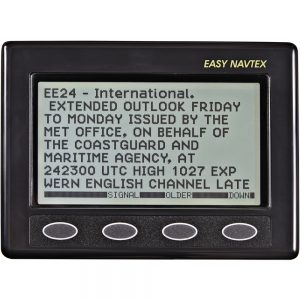USA: US Coast Guard plans to terminate NAVTEX
The US Coast Guard may cease broadcasting of NAVTEX (Navigational Telex) but only after it is available on IMO recognized satellite services.
Published 5 years ago


- NAVTEX Receiver ©NASA Marine
NAVTEX is an international automated service for radio broadcast delivery of navigational and meteorological warnings and forecasts, as well as urgent maritime safety information.
The receiving equipment consists of an aerial and 12v volt receiver with an integrated display. Some systems, costing as little as $150, have Bluetooth capability which transmits the received information to a PC. Smartphone or tablet.
NAVTEX provides continuous updates for a number of services including navigational and met warnings, search and rescue information and pirate warnings and does so every 4 hours. It is widely used and many would consider it an essential aid to navigation and safety.
Discontinued Service
The US coastguard has announced that:
“It is proposing to cease operating MF NAVTEX and, instead making this information available via IMO recognized satellite services in waters under U.S. responsibility. The current MF NAVTEX equipment is in dire need of replacement. The equipment is antiquated and essential replacement parts are difficult to find and expensive, placing overall operation of MF NATEX at risk.”
Any approved GMDSS satellite terminal will be able to receive this information.
USCG believe the transition from terrestrial broadcast to satellite will provide for more reliable delivery of NAVTEX information and allow better, more cost-effective products in the future. They also believe this change will have a low impact on the maritime public as satellite receivers have become more prevalent onboard vessels.
Feedback
Before terminating the broadcast, the USCG will consider comments from the public.
Comments on the proposal to make the NAVTEX information available over satellite are welcomed, plus how you would be affected if they did provide the NAVTEX information via satellite, particularly if you use MF NAVTEX and do not currently have a GMDSS satellite terminal onboard your vessel.
They would also like comments on types of Maritime Safety Information products that might be added in the future if they did provide the NAVTEX information via satellite.
Comments must be submitted to the online docket USCG-2019- 0702 via http://www.regulations.gov, on or before 12 November 2019.
After considering any comments received, the USCG will issue a notice in the Federal Register indicating how the matter will be resolved.
For more information on MF NAVTEX in the U.S., see the USCG Navigation Center website.
………………………….
As Reported By :
https://www.regulations.gov/document?D=USCG-2019-0702-0001
Noonsite has not independently verified this information.
Our thanks to Joan Conover of the SCCA for forwarding this information.
Related to following destinations: USA
Related to the following Cruising Resources: Communications, Communications Equipment, Forecast Services, Piracy & Security, Piracy-Related Organisations and Websites, Weather
Related to the following Services, Goods and Amenities: Electrics and Electronics, Monitoring and Security Equipment, Navigation Tools, Repairs and Equipment







While that might work for ships, which already have a GMDSS satellite terminal fitted anyways, it’s very bad news for us yachties.
From https://en.wikipedia.org/wiki/Global_Maritime_Distress_and_Safety_System
“As of April 2018 the only provider of GMDSS satellite services is INMARSAT”
“The types of Inmarsat ship earth station terminals recognized by the GMDSS are: Inmarsat C and F77”
“Unfortunately Fleet 77 [F77] has an end of life scheduled for 1st of December 2020. No definite alternatives are currently defined.”
That means the only way to receive this information once the MF Navtex is shut down is an Inmarsat C terminal, which is neither small nor cheap compared to current Navtex receivers. Example unit: https://www.bluesat.com/sailor-6110-mini-c-gmdss-system.html